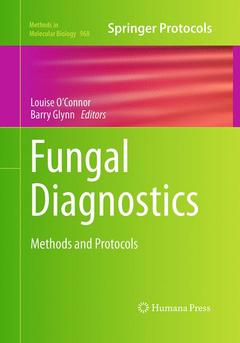Description
Fungal Diagnostics, 2013
Methods and Protocols
Methods in Molecular Biology Series, Vol. 968
Coordinators: O'Connor Louise, Glynn Barry
Language: English
Subject for Fungal Diagnostics:
Publication date: 08-2016
Support: Print on demand
Publication date: 01-2013
215 p. · 17.8x25.4 cm · Hardback
Description
/li>Contents
/li>Comment
/li>
Invasive fungal infections are a significant cause of morbidity and mortality. Over the past decade there has been a concerted effort to develop reliable methods for the detection of such infections. In Fungal Diagnostics: Methods and Protocols, expert researchers in the field detail the introduction of new technology into a diagnostic setting include ease of use, and rapid turnaround time without compromising sensitivity and specificity. Focusing specifically on fungal detection in clinical settings, fungal diagnostics including, environmental testing, agriculture and food production and veterinary diagnostics. Written in the highly successful Methods in Molecular Biology? series format, chapters include introductions to their respective topics, lists of the necessary materials and reagents, step-by-step, readily reproducible laboratory protocols, and key tips on troubleshooting and avoiding known pitfalls.
Authoritative and practical, Fungal Diagnostics: Methods and Protocols seeks to aid scientists into the further study of diagnostic and detection of fungi.
Overview of Invasive Fungal Infections.-Fungal Diagnostics: Review of Commercially Available Methods.-Rapid Methods for the Extraction and Archiving of Molecular Grade Fungal Genomic DNA.-Apex DNA Microarray for the Identification of Pathogenic Fungi.-Microscopic Detection of Yeasts using Fluorescence in situ Hybridization.-Quantitative Detection of Aspergillus spp. by Real-time Nucleic Acid Sequence-Based Amplification (NASBA).-Differentiation of Fungi using Hybridization Probes on the LightCycler® .-Quantitative and Multiplex Detection of Pathogenic Fungi using Padlock Probes, Generic qPCR and Suspension Array Readout.-Species-Specific Identification of a Wide Range of Clinically Relevant Fungal Pathogens by the Luminex xMAP Technology.-Applied Gene Histopathology: Identification of Fusarium Species in FFPE Tissue Sections by in situ Hybridization.-Application of Chip-based Flow Cytometry for Amphotericin B and Fluconazole Susceptibility Testing on Candida Strains.-Surface Plasmon Resonance Genosensor for the Detection of Fusarium culmorum.-Hyperbranching Rolling Circle Amplification (HRCA), An Improved Protocol for Discriminating Between Closely Related Fungal Species.-Loop-mediated Isothermal Amplification Based Detection of Fusarium graminearum.-Multiplex-Tandem PCR for Fungal Diagnostics.-Specific Detection of Pneumocystis jirovecii in Clinical Samples by Flow Cytometry.
These books may interest you

Human Fungal Pathogens 193.28 €



